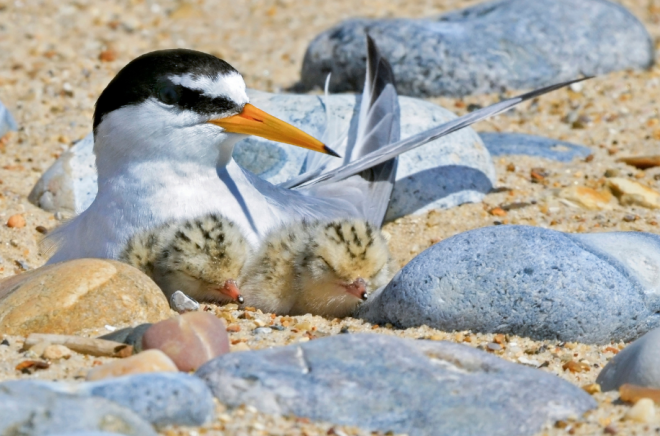Islay Airport creates safe landing zone for Little Terns

Highlands and Islands Airports Limited staff have teamed up with conservation programme Species on the Edge to create safe nesting habitat for the rare Little Tern at Islay Airport.
Little Terns fly to Scotland in spring to breed, looking for beaches on the coast and islands where they can nest in colonies. Unfortunately, this chosen habitat of Little Terns is often prone to disturbance by humans, dogs, and flooding. Little Terns are very sensitive to disturbance and can abandon nests, eggs and chicks if disturbed.
The latest breeding seabird census (Seabirds Count: 2015-2021) shows that Little Tern have declined by 29% in the last 20 years in Scotland, with the Argyll and Bute region seeing a much larger decline of 46% in the same time period. Creating disturbance-free areas with suitable nesting material is one of the most important actions that can be taken to help protect Little Terns.
The Little Tern is one of 37 rare and vulnerable species being supported through the new, multi-partner conservation programme, Species on the Edge. The multi-million pound programme, funded by The National Lottery Heritage Fund, is active across seven landscapes-scale areas in Scotland, working with local groups and communities to secure a future for Scotland’s most at-risk coastal species.
Staff from Species on the Edge, Islay Airport and RSPB have teamed up to create a ‘safe haven’ for Little Terns to rear their chicks. After a disused section of runway near the shore was identified as an ideal spot, local beach material and aggregate sourced by Islay airport and donated from local suppliers was spread across the area to create new Little Tern habitat.
To signal to Little Terns that this newly created habitat is a safe zone for breeding, Little Tern decoys produced through Species on the Edge have been placed on the site. These decoys are replicas of the Little Terns and are 3D printed in white plastic and painted. Little Terns nest in colonies and identify safe areas by looking for other nesting Little Terns, so it is hoped that this will attract any Little Tern close by.
The newly created nesting habitat will also benefit other species facing declines, such as Ringed Plover which utilise similar habitat for nesting.
Lucy Atkinson, Species on the Edge Project Officer in Islay, said:
“We’re delighted at the creation of this important nesting habitat for Little Terns thanks to the dedication from local staff at Islay airport and HIAL. We will be monitoring the area over the breeding season and are excited to see the positive impact for our ground-nesting birds.”
Fiona Strachan, Species on the Edge Programme Manager, said:
“It’s great to see this collaborative effort to support Little Terns on Islay. The terns need our help now more than ever and this is an excellent example of the kind of partnership we are encouraging across our project areas. We’re very grateful to all involved and are keeping our fingers crossed for a successful breeding season for the terns.”
Niall Colthart, Islay Airport Manager, said
“I'm delighted by our collaboration with Species on the Edge and RSPB to create a safe nesting habitat for Little Terns on this beautiful island. This initiative not only helps protect a vulnerable species but also underscores our commitment to environmental stewardship. By repurposing a disused section of our runway, we're ensuring that these remarkable birds have a secure place to breed and thrive, contributing to the conservation of Islay's natural heritage.”
Gayle Barclay, Head of Environment and Sustainability with Highlands and Islands Aiports, said:
"As caretakers of our environment, we at Highlands and Islands Airports Limited are proud to collaborate with Species on the Edge and RSPB in creating a sanctuary for Little Terns at Islay Airport. By transforming a disused section of our runway into a disturbance-free nesting habitat, we aim to provide a safe haven where these vulnerable birds can thrive. Our commitment to conservation extends beyond our operational duties, reflecting our dedication to preserving biodiversity and supporting local ecosystems."
Species on the Edge is a multi-partner species conservation programme dedicated to working with communities across Scotland’s coasts and islands to help them secure a future for their local vulnerable and threatened wildlife. Funded by The National Lottery Heritage Fund, the partnership consists of Amphibian and Reptile Conservation, Bat Conservation Trust, Buglife, Bumblebee Conservation Trust, Butterfly Conservation, NatureScot, Plantlife, and RSPB Scotland. The programme is active across seven landscape-scale areas in Scotland: Argyll and the Inner Hebrides; Outer Hebrides; North Coast; Orkney; Shetland; East Coast; Solway Coast.


